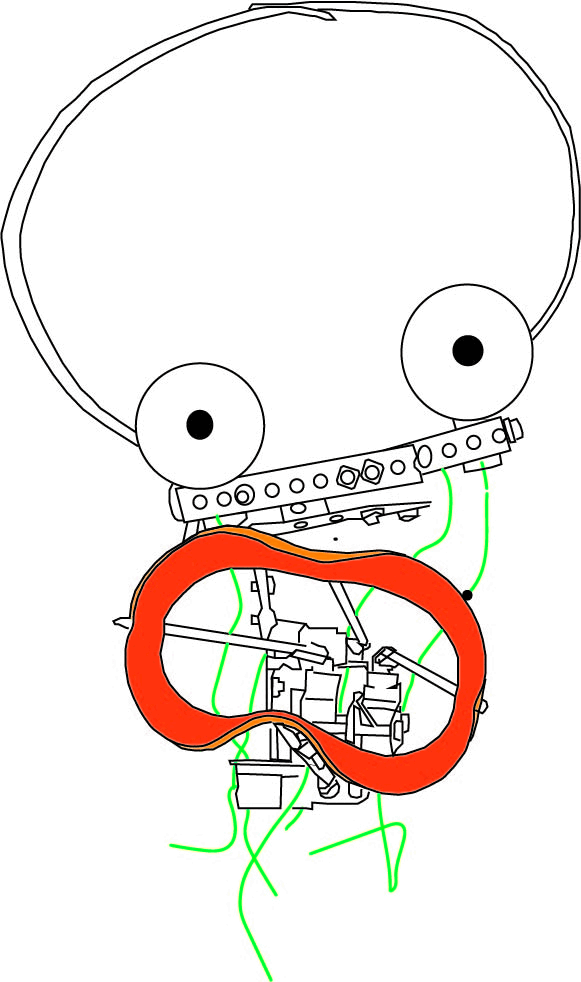
A geek song tour that is half tire, half punk has been born, it's not correct and it feels good!
The day Thomas Sillard introduced me to his new machine, LA TÊTE, I immediately loved its look and its cheekiness: it talks all the time and too loudly, it understands nothing, it gets carried away, it is rude, "too much" but yet we always want to listen to it.
It's true that it can do anything: beneath its appearance of harmless DIY, its irreverence and freedom of speech hit the mark. Thomas Sillard has probably found through this super-lively machine an outlet, a space of freedom and childlike insolence that feels good and touches people directly.
We therefore proposed to the prolific and rebellious Kim Giani, a great accomplice of the company, to write and compose custom songs for the creature. From there, the desire came to create giant sound and motorized mouths to make them its choristers.
In January 2025, we set out to test this concept in Seine Maritime, taking advantage of a residency-mediation project in a school, with the municipality of Petit Caux and DSN-Dieppe Scène nationale. Thus, surrounded by children, LA TÊTE sang on stage for the first time. We couldn't have dreamed of better: the children were as delighted as we were to meet it and to sing its cheeky refrains.
An interpreter of the third kind
LA TÊTE is a sensitive, vulnerable, touching machine that interprets its songs with sincerity, sometimes loses patience with its choristers, rallies its audience, doubts itself, sometimes gets depressed, often laughs. What makes it so alive and endearing is its simplicity of being, in direct relation with the audience, in a very raw rock and roll form.
The whole challenge of this song tour - supported by a complex puppetry and technological device - will be to keep intact this flame, this direct and sincere relationship of LA TÊTE with the audience but also with the character of the stage manager and the other puppets.
So no exuberant scenography or staging, but the choice of a stripped-down form in homage to the aesthetics of song tours, with a few points of color in motion, theatrical play dynamics, and effective dialogues to highlight the songs of the sensitive creature: songs like so many surreal, existential, touching, and funny poems, going straight to the heart, to the humor and intelligence of children and/or adults.
A scenography of living objects
The stripped-down scenography of La Tête's song tour offers the audience an active and unprecedented experience: by materializing sound and music in sound puppetry objects endowed with movement, it recomposes the space through the visual spatialization of sound. Hyper concrete, pop, playful, and hypnotic, it strongly invokes the imagination of the spectators.
LA TÊTE is set up on its wheeled foot, surprisingly alive. An orange rubber for a mouth, a few bolts, a twisted metal ring sketching its skull, two ping pong balls for its movable eyes, small motors, wires: it is a cobbled-together machine and does not pretend to be anything else, even if sometimes it’s hard since food passes through it, as it confides in its song "Sushi," that sand scratches and bores it in "La nature," that it is never safe on tour due to voltage problems in "Tête de gondole," and that it is especially lazy in "J’veux pas faire des trucs."
Around it, 11 giant mouths in bright colors, with their bright red speaker glottis, seem to be suspended at the end of their long, thin steel stems.
As the mouths move by the stage manager, the installation transforms: sections of a classical choir, unbridled choristers, a rock band, a vocal ensemble of human beatbox or artifacts of musical instruments, the mouths embody each composition and play all roles brilliantly.
Voluble and swift, they snap and sway to the rhythm of their songs, and their words inhabit the space, like giant eyes or hallucinatory butterflies. Capable of autonomy, they occasionally speak up, grumble against LA TÊTE, demand adjustments, in short, they are totally alive!
A giant remote control, à la Gondry, with its colorful arcade game buttons plays with this apparent sobriety and gives the whole a disconcerting DIY touch. It is from this remote control that the stage manager (or sometimes even the audience) can decide the order of the songs in the show.
